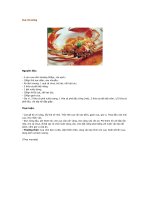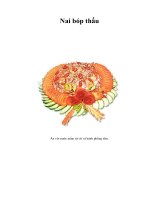Tài liệu Simple Atmospheric Perspective ppt
Bạn đang xem bản rút gọn của tài liệu. Xem và tải ngay bản đầy đủ của tài liệu tại đây (854.38 KB, 8 trang )
SIMPLE
PERSPECTIVE
Brenda Hoddinott
E-03 BEGINNER: PERSPECTIVE ONE
In this lesson, you render a simple mountain range consisting of foreground, middle ground, and
distant space, by using two components of perspective, overlapping and atmospheric perspective.
Overlapping is a technique that gives the illusion of depth in a drawing, and refers to the position
of subjects in a composition, when one visually appears to be in front of another (or others).
Atmospheric perspective (sometimes called aerial perspective) refers to the visual depth created
by various particles in the atmosphere. The farther an object recedes into the distance, the lighter
in value it seems to become, and its edges and forms appear more blurred.
This lesson is divided into the following three parts:
INTRODUCTION: An illustrated discussion introduces overlapping, atmospheric
perspective, foreground, middle ground, and distant space.
OUTLINING OVERLAPPING MOUNTAINS: Three overlapping mountains are
sketched within a rectangular drawing format, beginning with the one that is closest (the
foreground) and working back toward the distant mountain and the sky (distant space).
GIVING DEPTH TO A MOUNTAIN RANGE: Shading is added to the sky and
mountains with squirkles to render the illusion of depth as a result of various types of
particles in the atmosphere.
This project is recommended for artists and aspiring artists of all ages, as well as
home schooling, academic and recreational fine art educators.
8 PAGES – 13 ILLUSTRATIONS
Published by Hoddinott Fine Art Publishers, Halifax, NS, Canada, 2005 (Revised 2006)
Copyright to all articles, images, text, projects, lessons and exercises within this drawing class belong to Brenda Hoddinott and may
not be reproduced or used for any commercial purposes whatsoever without the written permission of Brenda Hoddinott.
Web sites and
2
INTRODUCTION
In this lesson, you render a simple mountain range by using two components of perspective,
overlapping and atmospheric perspective. Various elements of perspective are used to help create
the illusion of three-dimensional spaces in drawings. Perspective is a method of representing
subjects (and the individual parts of subjects) in a drawing, in such a way that they seem to
recede into distant space, and appear smaller the farther they are away from you.
Overlapping
Overlapping is a technique that gives the illusion of depth in a drawing, and refers to the position
of subjects in a composition, when one visually appears to be in front of another (or others). The
term composition refers to the arrangement of the various facets of your drawing subject within
the borders of a drawing space.
ILLUSTRATION 03-01
A drawing space (also called the drawing surface or drawing
format) is the area in which you render a drawing within a specific
perimeter. A drawing space can be separated into foreground,
middle ground, and distant space by overlapping (or layering)
objects in front of one another.
In this square drawing space, the largest happy face (in the
foreground at the bottom) is overlapping (in front of) the medium-
sized one in the middle ground. The medium-sized happy face is
overlapping the one farthest away (in distant space).
Atmospheric perspective
Atmospheric perspective (sometimes called aerial perspective) refers to the visual depth created
by various particles in the atmosphere. The farther an object recedes into the distance, the lighter
in value it seems to become, and its edges and forms appear more blurred. Even on a clear day,
your ability to see distant objects is decreased by an assortment of atmospheric components, such
as minuscule particles of dust and/or pollen and/or tiny droplets of moisture. Your vision
becomes further diminished when the atmosphere is filled with haze, fog, smoke, rain or snow.
Even fairly close-up objects can appear out of focus or almost invisible under certain conditions.
ILLUSTRATION 03-02
As you examine this drawing, observe how
atmospheric perspective creates the illusion of
depth in a forest.
The trees in the front are drawn with more
details and have more contrasting values than
the ones in the distance. Their shadows are
darker, and their highlights are brighter. Distant
trees are lighter in value and less detailed.
Copyright to all articles, images, text, projects, lessons and exercises within this drawing class belong to Brenda Hoddinott and may
not be reproduced or used for any commercial purposes whatsoever without the written permission of Brenda Hoddinott.
Web sites and
3
The following cartoon drawing of a bunch of blobs in a fog demonstrates both overlapping and
atmospheric perspective. Take note of which blobs are overlapping (in front of) others.
ILLUSTRATION 03-03
The light fog represents atmospheric
perspective and shows how your ability to see
into the distance can be diminished by
moisture particles in the air.
You can plainly see the crisp shading lines of
Billy Blob (the shy blob in the front center),
who is the closest to you. However, the farther
away the blobs are from the foreground, the
fewer details you can see. The blobs in the
distant space are barely visible at all!
OUTLINING OVERLAPPING MOUNTAINS
In this section, you sketch three mountains beginning with the one that is closest (the foreground)
and working back toward the distant mountain and the sky (distant space).
ILLUSTRATION 03-04
1. Outline a horizontal
rectangle (similar in shape to
mine) as your drawing space.
A horizontal rectangle is often
referred to as a landscape
format. You can either turn
your drawing paper
horizontally, or you can use a
ruler to draw a rectangle as
your drawing space.
ILLUSTRATION 03-05
2. Sketch the outline of a
mountain in the foreground.
When planning to overlap
objects, I generally find it
easier to draw objects in the
foreground first.
Try to draw the outlines of the
mountains in approximately the
same locations as in my
sketches.
Copyright to all articles, images, text, projects, lessons and exercises within this drawing class belong to Brenda Hoddinott and may
not be reproduced or used for any commercial purposes whatsoever without the written permission of Brenda Hoddinott.
Web sites and
4
ILLUSTRATION 03-06
3. Outline a second mountain behind
the first.
This mountain represents the middle
ground.
No need to make the shapes of the
mountains exactly like mine. Feel
free to draw them more rounded or
jagged.
4. Add the third mountain in the distant space behind the other two.
Because this mountain is farther away than the others, the peaks should be somewhat smaller.
ILLUSTRATION 03-07
GIVING DEPTH TO A MOUNTAIN RANGE
In this section, you add shading to render the illusion of depth as a result of various particles in
the atmosphere. Shading is the process of adding values to a drawing so as to create the illusion
of form and/or three-dimensional spaces. Values are the different shades of gray created in a
drawing by various means, such as varying the density of the shading lines and/or the pressure
used in holding a pencil.
Squirkling is an easy method of shading, in which randomly drawn curved lines (called
squirkles) combine squiggles and scribbles with circles to create values. Squirkles tend to look
best when the curved lines are very randomly drawn and of different shapes and sizes.
If you are not familiar with the shading technique I call squirkling, please refer to beginner
lesson D-01 Squirkling Values.
Copyright to all articles, images, text, projects, lessons and exercises within this drawing class belong to Brenda Hoddinott and may
not be reproduced or used for any commercial purposes whatsoever without the written permission of Brenda Hoddinott.
Web sites and
5
5. Use a 2H pencil and squirkles to add a very light value to the sky behind the mountains.
ILLUSTRATION 03-08
Press very
gently with
your pencil
so the
squirkle
lines are
very light!
6. Use an HB pencil to add shading to the mountain in the distant space.
This mountain needs to be darker than the sky. However, keep in mind that the two closer
mountains need to be quite a bit darker, so be careful not to make this shading too dark. Use
a gentle graduation of values to give this mountain a little form.
A graduation is a continuous progression of values from dark to light or from light to dark.
Form refers to the three-dimensional structures of shapes.
ILLUSTRATION 03-09









